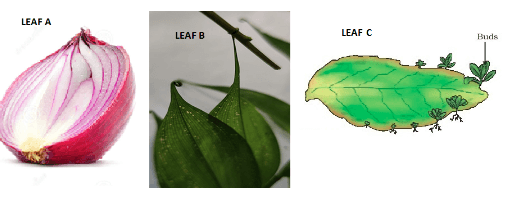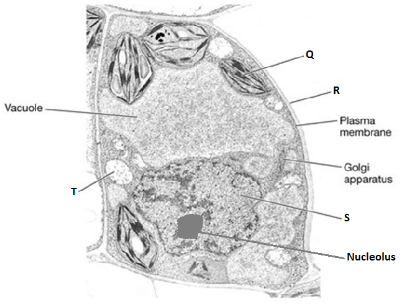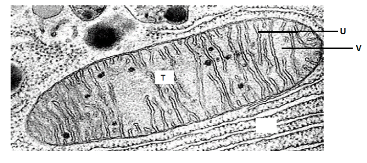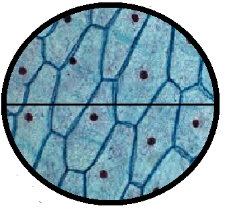- Candidates should answer the questions in English.
- You are provided with specimens J, K and L.
-
- identify specimen J. (1mk)
- Give a reason for your answer in a) (i) above. (1mk)
- Using the scalpel provided, carefully make a cross section of specimen J.
- name the type of placentation (1mk)
- extract juice form specimen J and test it for vitamin C. (3mks)
Food tested Procedure Observation Conclusion
- Complete the table below using the specimens provided. (9mks)
specimen Agent of dispersal One adaptation of the specimen J K L
-
- The photographs below represents leaves from different plants.use them to answer the questions that follow.

- Each of the leaves A,B and C are modified to perform different functions. With a reason, state the functions. (10mks)
LEAF FUNCTION REASON A B C - State the type of evolution that may have led to the emergence of the different leaves shown in leaf A, B and C. (1mk)
- Name the type of evolution structure represented by the leaves above. (1mk)
- Name two examples of such structures as named in (b) (ii) above in aves. (2mks)
- Each of the leaves A,B and C are modified to perform different functions. With a reason, state the functions. (10mks)
- Below is a photomicrograph of a plant cell. Study it and answer the questions that follow.

-
- Label the parts labeled R, S and T. (3mks)
- Name the chemical compound that constitutes part labeled R above. (1mk)
- State the function of part labeled
- Q. (1mk)
- Nucleolus. (1mk)
- Below is an enlarged micrograph of organelle T.

- What is the function of organelle T.? (1mk)
- What is the biological significance of having numerous parts U in organelle T.? (1mk)
- A student observed onion epidermal tissue using a microscope whose field of view was ____________mm in diameter as shown below. Calculate the approximate width of one of the cell. (3mks)

-
CONFIDENTIAL
In addition to the apparatus found in biology laboratory, each candidate should be provided with:
- Ripe Yellow/purple passion fruit labeled specimen J.
- Dry black jack fruit labeled K.
- Fresh green peas/bean pod labeled specimen L.
- Hand lens.
- 3ml of DCPIP.
- Dropper.
- 50ml beaker.
- Filter funnel.
- Stirring rod.
- One test tube.
- Test tube rack.
MARKING SCHEME
- You are provided with specimens J, K and L.
-
- identify specimen J. (1mk)
- Fruit;
- Give a reason for your answer in a) (i) above. (1mk)
- Has two scars:
- identify specimen J. (1mk)
- Using the scalpel provided, carefully make a cross section of specimen J.
- name the type of placentation (1mk)
- extract juice form specimen J and test it for vitamin C. (3mks)
Food tested Procedure Observation Conclusion Vitamin C Put DCPIP solution in a test tube then add juice drop by drop as you shake; DCPIP declorisation; Vitamin C present;
- complete the table below using the specimens provided. (9mks)
(Mark 2mks for the adaptation.)specimen Agent of dispersal One adaptation of the specimen J Animal; -Brightly coloured; to attract the animal; -Fleshy/succulent; to attract the animals;-Slimy seeds with hard seedcoat; to resist digestion in the animals gut,hence released in feaces in viable state;-Scented; to attract animals;K Animal; -Has hooks; to attach to the animals fur/clothes;-Light; hence cannot be detected by the animal and thus be carried far distance;L Self explosive mechanism -Has satures/lines of weakness; in the pod along which they the pod breaks explosively throwing the seeds far away;
-
- The photographs below represents leaves from different plants.use them to answer the questions that follow.
- Each of the leaves A,B and C are modified to perform different functions. With a reason, state the functions. (10mks)
LEAF FUNCTION STORAGE A Storage Succulent/ swollen; B Photosynthesis Green in colour Support Has tendrils C Photosynthesis Its green; Reproduction has plantlets/buds; - State the type of evolution that may have led to the emergence of the different leaves shown in leaf A, B and C. (1mk)
- Divergent evolution;
- Name the type of evolution structure represented by the leaves above. (1mk)
- Homologous structure;
- Name two examples of such structures as named in (b) (ii) above in aves. (2mks)
- Beaks;
- Legs;
- Each of the leaves A,B and C are modified to perform different functions. With a reason, state the functions. (10mks)
- Below is a photomicrograph of a plant cell. Study it and answer the questions that follow.
-
- Label the parts labeled R, S and T. (3mks)
- R – Cell wall;
- S – Nucleus;
- T – Mitochondrion; (rej plural)
- Name the chemical compound that constitutes part labeled R above. (1mk)
- Cellulose;
- Label the parts labeled R, S and T. (3mks)
- State the function of part labeled
- Q. (1mk)
- Site for photosynthesis;
- Nucleolus. (1mk)
- Manufacture ribosomes;
- Q. (1mk)
- Below is an enlarged micrograph of organelle T.
- What is the function of organelle T.? (1mk)
- Site for respiration;
- What is the biological significance of having numerous parts U in organelle T.? (1mk)
- Increase surface area for attachment of more respiratory enzymes;
- What is the function of organelle T.? (1mk)
- A student observed onion epidermal tissue using a microscope whose field of view was ____________mm in diameter as shown below. Calculate the approximate width of one of the cell. (3mks)
-
Download Biology Paper 3 Questions and Answers with Confidential - Form 4 End Term 2 Exams 2023.
Tap Here to Download for 50/-
Get on WhatsApp for 50/-
Why download?
- ✔ To read offline at any time.
- ✔ To Print at your convenience
- ✔ Share Easily with Friends / Students

